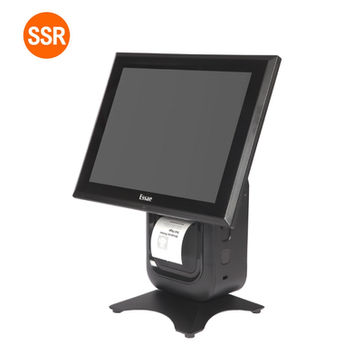POS Systems
Why Choose a POS Machine Over a Desktop?
Feature
POS Machine
Desktop Computer
Purpose
Designed for billing, transactions, and business management
General-purpose computing
Interface
Touchscreen with an easy-to-use UI
Keyboard and mouse navigation
Portability
Compact and mobile-friendly
Bulky and stationary
Hardware Integration
Built-in barcode scanner, printer, and card reader
Requires additional hardware
Reliability
Optimized for continuous use in retail and hospitality
May lag due to multitasking
Power Consumption
Energy-efficient
Higher power usage
If you run a business that requires fast transactions, inventory tracking, and multiple payment options, a POS Machine is the ideal choice over a traditional desktop.
POS 416N All-in-One Touchscreen POS System
The POS 416N is a sleek and compact all-in-one Point-of-Sale solution designed to streamline operations in retail, hospitality, and service environments. Equipped with a 15.6-inch touchscreen and powerful internal components, it offers a user-friendly interface, high performance, and flexible connectivity. Its modern design and reliable functionality make it ideal for fast-paced business environments.
-
15.6-inch Touch Display: High-resolution touchscreen with multi-touch capability for intuitive use
-
All-in-One Design: Integrates key components to save space and reduce cable clutter
-
Durable Build: Designed for long hours of operation in demanding retail and hospitality settings
-
Multiple Connectivity Options: Supports USB, Ethernet, serial ports, and optional WiFi/Bluetooth
-
Reliable Performance: Efficient processing power for smooth operation of POS applications
₹0.0
POS 415N Compact Touchscreen POS System
The POS 415N is a compact and efficient Point-of-Sale terminal designed for reliable performance in demanding business environments. Featuring a streamlined 15.6-inch touchscreen interface and robust hardware, it offers easy operation, fast processing, and flexible integration with various POS peripherals. Its space-saving design and modern look make it a great choice for retail, food service, and service-oriented businesses.
-
15.6-inch Touchscreen: Crisp, responsive display for smooth and efficient interaction
-
Space-Saving Design: Compact footprint ideal for counters with limited space
-
Sturdy and Reliable: Built for continuous operation in busy commercial environments
-
Versatile Connectivity: Equipped with USB, Ethernet, and serial ports for peripheral integration
-
Cost-Effective Performance: Offers strong performance while maintaining energy efficiency
₹0.0
POS 615 Advanced All-in-One Touchscreen POS System
The POS 615 is a high-performance, all-in-one touchscreen POS system engineered for demanding business environments. With its robust design, modern interface, and powerful internal specs, the POS 615 delivers reliable performance for retail, F&B, and enterprise-level operations. It combines sleek aesthetics with powerful functionality, making it ideal for both front and back-end operations.
-
15.6-inch Full HD Touchscreen: High-resolution, multi-touch display for smooth and intuitive interaction
-
Powerful Hardware: Equipped with advanced processor options and storage for multitasking and speed
-
Modular Connectivity: Supports various I/O ports including USB, serial, LAN, and optional WiFi/Bluetooth
-
Durable Design: Rugged chassis suitable for high-traffic, long-hour usage
-
Flexible Integration: Easily integrates with barcode scanners, cash drawers, customer displays, and more
₹0.0
POS 815J High-End Touchscreen POS Terminal
The POS 815J is a premium all-in-one touchscreen POS terminal designed to deliver top-tier performance and seamless user experience in high-volume commercial environments. With an elegant design, robust construction, and powerful processing capabilities, it supports a wide range of business applications, making it a reliable choice for retail, F&B, and enterprise use.
-
15.6-inch Full HD Touchscreen: High-resolution, multi-touch display for smooth and intuitive interaction
-
Powerful Hardware: Equipped with advanced processor options and storage for multitasking and speed
-
Modular Connectivity: Supports various I/O ports including USB, serial, LAN, and optional WiFi/Bluetooth
-
Durable Design: Rugged chassis suitable for high-traffic, long-hour usage
-
Flexible Integration: Easily integrates with barcode scanners, cash drawers, customer displays, and more
₹0.0
POS 816J Widescreen Touchscreen POS Terminal
The POS 615 is a high-performance all-in-one touchscreen POS system engineered for demanding business environments. With its robust design, modern interface, and powerful internal specs, the POS 615 delivers reliable performance for retail, F&B, and enterprise-level operations. It combines sleek aesthetics with powerful functionality, making it ideal for both front and back-end operations.
-
15.6-inch Full HD Touchscreen: High-resolution, multi-touch display for smooth and intuitive interaction
-
Powerful Hardware: Equipped with advanced processor options and storage for multitasking and speed
-
Modular Connectivity: Supports various I/O ports including USB, serial, LAN, and optional WiFi/Bluetooth
-
Durable Design: Rugged chassis suitable for high-traffic, long-hour usage
-
Flexible Integration: Easily integrates with barcode scanners, cash drawers, customer displays, and more
₹0.0
Essae POS-865J with inbuilt printer
The CAT POS-865J is a compact, stylish, and powerful all-in-one POS (Point of Sale) system designed for smooth operations in retail, restaurants, and billing counters. It features a responsive touchscreen, fast processing, and versatile connectivity to handle daily transactions efficiently.
-
15.6” Full HD Touch Display—Clear and responsive touchscreen for quick operation
-
Powerful Intel Processor—Ensures fast performance and smooth multitasking
-
Compact Design—Saves space and looks professional on any counter
-
Multiple Ports—USB, LAN, and more for easy connection with printers, scanners, and cash drawers
-
Reliable Build—Durable and made for busy work environments
-
Fanless Operation—Silent and low-maintenance system











